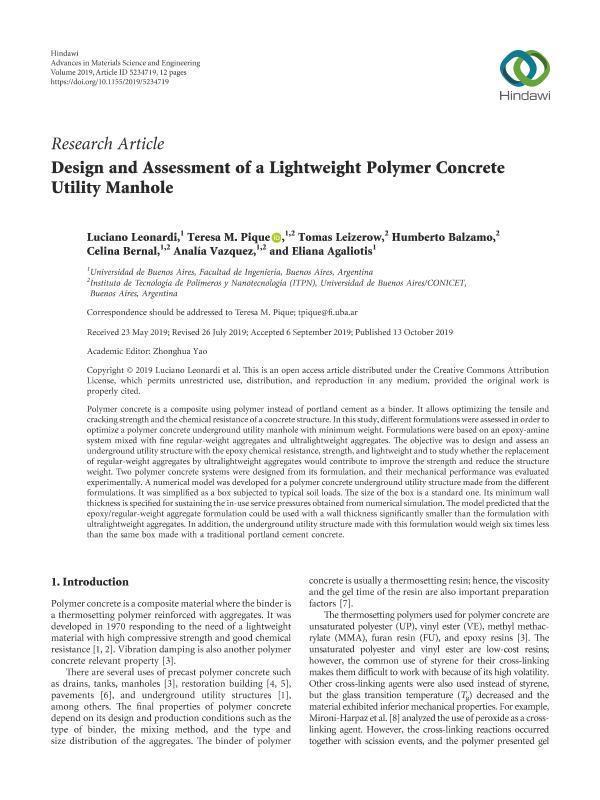Mostrar el registro sencillo del ítem
dc.contributor.author
Leonardi, Luciano Ariel

dc.contributor.author
Piqué, Teresa María

dc.contributor.author
Leizerow, Tomas
dc.contributor.author
Balzamo, Humberto Marcelo

dc.contributor.author
Bernal, Celina Raquel

dc.contributor.author
Vazquez, Analía
dc.contributor.author
Agaliotis, Eliana Mabel

dc.date.available
2021-01-04T15:24:39Z
dc.date.issued
2019-10
dc.identifier.citation
Leonardi, Luciano Ariel; Piqué, Teresa María; Leizerow, Tomas; Balzamo, Humberto Marcelo; Bernal, Celina Raquel; et al.; Design and Assessment of a Lightweight Polymer Concrete Utility Manhole; Hindawi Publishing Corporation; Advances in Materials Science and Engineering; 2019; 10-2019; 1-12
dc.identifier.issn
1687-8434
dc.identifier.uri
http://hdl.handle.net/11336/121385
dc.description.abstract
Polymer concrete is a composite using polymer instead of portland cement as a binder. It allows optimizing the tensile and cracking strength and the chemical resistance of a concrete structure. In this study, different formulations were assessed in order to optimize a polymer concrete underground utility manhole with minimum weight. Formulations were based on an epoxy-amine system mixed with fine regular-weight aggregates and ultralightweight aggregates. The objective was to design and assess an underground utility structure with the epoxy chemical resistance, strength, and lightweight and to study whether the replacement of regular-weight aggregates by ultralightweight aggregates would contribute to improve the strength and reduce the structure weight. Two polymer concrete systems were designed from its formulation, and their mechanical performance was evaluated experimentally. A numerical model was developed for a polymer concrete underground utility structure made from the different formulations. It was simplified as a box subjected to typical soil loads. The size of the box is a standard one. Its minimum wall thickness is specified for sustaining the in-use service pressures obtained from numerical simulation. The model predicted that the epoxy/regular-weight aggregate formulation could be used with a wall thickness significantly smaller than the formulation with ultralightweight aggregates. In addition, the underground utility structure made with this formulation would weigh six times less than the same box made with a traditional portland cement concrete.
dc.format
application/pdf
dc.language.iso
eng
dc.publisher
Hindawi Publishing Corporation

dc.rights
info:eu-repo/semantics/openAccess
dc.rights.uri
https://creativecommons.org/licenses/by/2.5/ar/
dc.subject
Concreto polimerico
dc.subject
Simulaciones computacionales
dc.subject
Materiales compuestos
dc.subject.classification
Compuestos

dc.subject.classification
Ingeniería de los Materiales

dc.subject.classification
INGENIERÍAS Y TECNOLOGÍAS

dc.title
Design and Assessment of a Lightweight Polymer Concrete Utility Manhole
dc.type
info:eu-repo/semantics/article
dc.type
info:ar-repo/semantics/artículo
dc.type
info:eu-repo/semantics/publishedVersion
dc.date.updated
2020-11-19T21:35:46Z
dc.journal.volume
2019
dc.journal.pagination
1-12
dc.journal.pais
Egipto

dc.description.fil
Fil: Leonardi, Luciano Ariel. Consejo Nacional de Investigaciones Científicas y Técnicas. Oficina de Coordinación Administrativa Houssay. Instituto de Tecnología en Polímeros y Nanotecnología. Universidad de Buenos Aires. Facultad de Ingeniería. Instituto de Tecnología en Polímeros y Nanotecnología; Argentina
dc.description.fil
Fil: Piqué, Teresa María. Consejo Nacional de Investigaciones Científicas y Técnicas. Oficina de Coordinación Administrativa Houssay. Instituto de Tecnología en Polímeros y Nanotecnología. Universidad de Buenos Aires. Facultad de Ingeniería. Instituto de Tecnología en Polímeros y Nanotecnología; Argentina
dc.description.fil
Fil: Leizerow, Tomas. Consejo Nacional de Investigaciones Científicas y Técnicas. Oficina de Coordinación Administrativa Houssay. Instituto de Tecnología en Polímeros y Nanotecnología. Universidad de Buenos Aires. Facultad de Ingeniería. Instituto de Tecnología en Polímeros y Nanotecnología; Argentina
dc.description.fil
Fil: Balzamo, Humberto Marcelo. Consejo Nacional de Investigaciones Científicas y Técnicas. Oficina de Coordinación Administrativa Houssay. Instituto de Tecnología en Polímeros y Nanotecnología. Universidad de Buenos Aires. Facultad de Ingeniería. Instituto de Tecnología en Polímeros y Nanotecnología; Argentina
dc.description.fil
Fil: Bernal, Celina Raquel. Consejo Nacional de Investigaciones Científicas y Técnicas. Oficina de Coordinación Administrativa Houssay. Instituto de Tecnología en Polímeros y Nanotecnología. Universidad de Buenos Aires. Facultad de Ingeniería. Instituto de Tecnología en Polímeros y Nanotecnología; Argentina
dc.description.fil
Fil: Vazquez, Analía. Consejo Nacional de Investigaciones Científicas y Técnicas. Oficina de Coordinación Administrativa Houssay. Instituto de Tecnología en Polímeros y Nanotecnología. Universidad de Buenos Aires. Facultad de Ingeniería. Instituto de Tecnología en Polímeros y Nanotecnología; Argentina
dc.description.fil
Fil: Agaliotis, Eliana Mabel. Consejo Nacional de Investigaciones Científicas y Técnicas. Oficina de Coordinación Administrativa Houssay. Instituto de Tecnología en Polímeros y Nanotecnología. Universidad de Buenos Aires. Facultad de Ingeniería. Instituto de Tecnología en Polímeros y Nanotecnología; Argentina
dc.journal.title
Advances in Materials Science and Engineering
dc.relation.alternativeid
info:eu-repo/semantics/altIdentifier/url/https://www.hindawi.com/journals/amse/2019/5234719/
dc.relation.alternativeid
info:eu-repo/semantics/altIdentifier/doi/http://dx.doi.org/10.1155/2019/5234719
Archivos asociados
